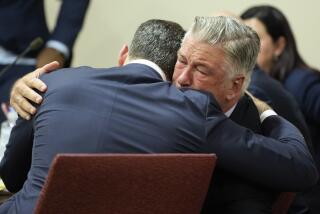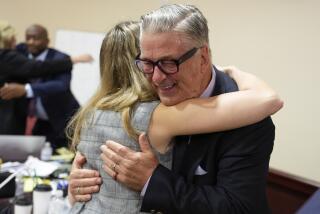NEWS ANALYSIS : Prosecution’s Bold Move May Backfire
For the prosecution, it was to have been a triumphant moment of high courtroom theater: The defendant in the most celebrated murder trial of modern times slipping on the gloves that would link him to the murders of his ex-wife and her friend. Instead, analysts said, it could turn out to be the government’s most costly gaffe.
When O.J. Simpson tugged at the bloodstained gloves, he wrenched, pulled and announced that they were too small. Jurors looked spellbound, defense attorneys could barely contain their glee and some legal analysts said prosecutors had committed the most egregious mistake of the trial, a blunder so serious that some say it could endanger their entire case.
*
“This could be the prosecution’s worst nightmare,” said Laurie Levenson, a Loyola Law School professor and former federal prosecutor. “I think the entire case could come down to jurors saying: ‘Why doesn’t this glove fit?’ ”
Levenson called the demonstration the prosecution’s “biggest setback” and warned that it could undo many of the points the government team has made so far in its effort to prove that Simpson murdered Nicole Brown Simpson and Ronald Lyle Goldman--charges that Simpson has vigorously denied.
“DNA alleles and coroner’s testimony on medical issues is technical,” she said. “Watching a hand go into a glove--or not go into a glove--that leaves an image. That’s something the jury will understand. That’s something they will remember.”
Not all analysts were convinced that the demonstration was an abject failure for the prosecution. Some praised Deputy Dist. Atty. Christopher A. Darden for daring to run the experiment in front of the jury, and said they believed the gloves fit well enough to make the prosecution’s case, especially given the limitations of the demonstration.
“It was a very gutsy, aggressive and smart move by Chris Darden to have Simpson try on the gloves in front of the jury,” said former Los Angeles County Dist. Atty. Robert Philibosian. “To the naked eye, they appeared tight, but they did fit. More important, the manufacturer’s representative testified that at ‘one point in time’ those particular gloves would have fit. Presumably, they shrink if they are soaked with moisture--like blood.”
At first Darden appeared dejected after the demonstration. Outside court, he said: “We looked at his hands, we looked at the gloves. And even in their present condition, they should fit and do fit.”
Other observers were less charitable.
“Unbelievable,” said Harland W. Braun, a criminal defense lawyer and former Los Angeles County deputy district attorney.
“A fiasco,” said defense lawyer Barry Tarlow.
“Potentially devastating,” said Steven D. Clymer, a former assistant U.S. attorney and now a Cornell University law professor.
“The gang that can’t shoot straight,” Santa Monica defense lawyer Gigi Gordon said of the prosecution team.
Almost without exception, those analysts and others sharply criticized the prosecution for staging a demonstration that allowed Simpson to control the action and for asking him to try on the gloves in front of the jury without testing it first outside the panel’s presence.
Both those decisions, they said, violated a cardinal rule of courtroom lawyering: Never ask a question that you don’t know the answer to. In this case, the violation of the rule was even more striking precisely because the demonstration was so dramatic.
Deputy Dist. Atty. Sterling Norris, a veteran prosecutor in the Los Angeles County district attorney’s office, sympathized with his colleagues, saying that it is sometimes difficult to know how to handle a demonstration such as the one Darden attempted.
“You can measure his hands, but then you’ve alerted him,” Norris said. “If the measurements turned out to be bad, you’d have to turn them over.”
Instead, Darden rolled the dice, betting that the gloves would fit Simpson and that the jurors would see the match for themselves. Even then, however, the defense had ample warning. Simpson’s lead trial lawyer, Johnnie L. Cochran Jr., already had tried on the gloves in court.
Cochran’s hands are significantly smaller than those of his client, a former football star.
*
Had Darden’s gambit worked, observers agreed, the result would have been a vivid connection of Simpson to the gloves, one of which was recovered near the bodies, the other of which was found outside his Brentwood mansion.
The trouble, analysts said, was that the demonstration came off as badly flawed. Although Simpson did not seem distressed as he pulled on the bloodstained gloves allegedly worn to kill his ex-wife, he apparently struggled to make them fit. When he held up his hands for the jury, the gloves did not fully cover his wrists.
“They could have measured the pattern of his hand against the pattern of the glove instead of having this circus-like display in court which obviously backfired,” said Gordon. “Whether or not the glove really fits O.J., I can’t tell you. All I know is it didn’t look like it did.”
The demonstration was all the more costly, some observers said, because it capped a day in which the prosecution seemed to be building momentum. Skillful sleuthing and smoothly presented testimony about the gloves had demonstrated convincingly that only a very small number of people had gloves that would match those in the Simpson case, and a credit card receipt suggested that Nicole Simpson was one of them.
But while the testimony suggested that Simpson could have had access to such gloves, the demonstration appeared to cast doubt on the prosecution’s own evidence.
“The problem with a dramatic demonstration,” Braun said, “is that it can be a dramatic disaster.”
Once Simpson had wrenched the gloves into place, Darden succeeded in getting him to hold a pen--attempting to reinforce the notion that he could have wielded a knife. But Simpson’s actions foiled that effort as well; he gripped the pen awkwardly, again emphasizing the apparently ill-fitting gloves.
There were possible explanations other than that the gloves were the wrong size: Simpson was wearing latex gloves underneath the leather ones, which had been stained heavily with blood and then allowed to dry. Both of those facts could have affected their fit.
But by presenting the demonstration themselves, prosecutors implicitly vouched for the results, said Clymer, who successfully prosecuted two Los Angeles police officers charged with violating Rodney G. King’s civil rights.
“That was a huge gamble for the prosecution to take,” he said. “It sounds like they took it and lost.”
As prosecutors huddled in their end-of-the-day session, Cochran and his defense team colleagues returned to his Wilshire Boulevard offices, where they were nothing less than ecstatic.
“As I was walking out of the court today,” Cochran said, “all I could think was: The defense rests.”
More to Read
Sign up for Essential California
The most important California stories and recommendations in your inbox every morning.
You may occasionally receive promotional content from the Los Angeles Times.











